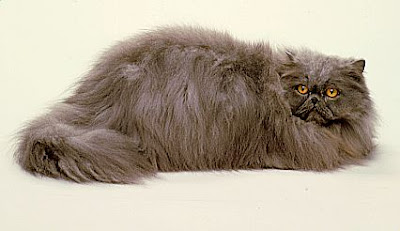Of all the Longhaired, the Blue's popularity has been the most enduring. One hundred examples of the breed were entered in the 1899 London Cat Show, and today there are special shows in Britain devoted solely to Blues. Carefully controlled breeding has ensured that the Blue most closely represents the standard laid down for Longhairs, and as a result it is frequently used to improve the type of other varieties.
History
Although longhaired blue cats have featured in artists' impressions for several centuries, and were well known in Renaissance Italy, the modern variety did not come into its own until the late nineteenth century. The breed probably originated from crossbreeding between Black and White Longhairs, and early examples showed tabby markings. The foundation of the Blue Persian Society in 1901 gave the breed considerable prestige, which was further enhanced by the patronage of Queen Victoria.
Temperament
The Blue Longhair has a well deserved reputation for being calm, considered, and above all gentle.
Varieties
There are no varieties.
Blue Longhair
The "blue" that gives the breed its name is in fact a dilute form of black that may more accurately be described as blue-grey.
 Head
HeadBroad and round with a snub nose and a Blue nose pad. The flattened face typical of the Longhair type shows clearly in profile.
Ears
Small and round-tipped.
Eyes
Large and round with a snub nose.
Facial Characteristics
Blue Longhair

Body
A solid, cobby type.
Coat
Luxuriant, thick, and silky. Any shade of blue is accepted, but paler shades are preferred. Coat should have no white hairs of markings of any kind.
Tail
Short and fluffy. Tail is usually carried straight and low.
Legs
Short and thick. Forelegs have much shorter fur than the hind legs
Feet
The paws should be large and round with blue pads.
